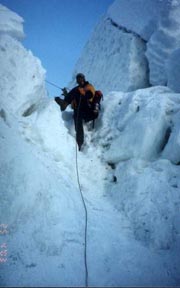EVEREST: Friendship Beyond Borders Expedition
First
Attempt, One Artificial Leg, Trained Enroute, Summit Success
Home
Press
Team
Our Story
Goals
Updates

Nawang had dreamed of climbing Mount Everest since he was a child growing up in the village of Tapting in the Solu-Khumbu region of Nepal.
Ed Hommer inspired him to hold on to his dream despite his disability. His goal became to be the first person to climb to the summit using a prosthetic leg.
Everest Expedition Goals and Objectives
The chief goal of this expedition was to help our friend Nawang Sherpa become the first person ever to climb Mount Everest, or any 8000 meter peak, using an artificial leg. We wanted to promote mountain fellowship and international peace and cooperation. And we wanted to showcase the Sherpa ethic as in inspirational example of what it takes to succeed against great challenges. Expedition objectives and unique characteristics included:
![]() The mountain area involved: Mount Everest (Chomolungma) in Sagarmatha
National Park, a UNESCO World Heritage site on the border of Nepal and
Tibet
The mountain area involved: Mount Everest (Chomolungma) in Sagarmatha
National Park, a UNESCO World Heritage site on the border of Nepal and
Tibet
![]() The route the expedition climbed was the South Col Route
The route the expedition climbed was the South Col Route
![]() The goal of this expedition was to facilitate the first ascent of Mount
Everest by Nawang Sherpa, a mountaineer and trans-tibial (below the knee)
amputee, who is now the first person with an artificial leg to climb Everest
The goal of this expedition was to facilitate the first ascent of Mount
Everest by Nawang Sherpa, a mountaineer and trans-tibial (below the knee)
amputee, who is now the first person with an artificial leg to climb Everest
![]() The style in which the mountain was climbed: We used a lightweight, low-impact
style. This was a non-commercial expedition of one American climber (Tom),
one Nepalese/Sherpa climber (Nawang) and three Sherpa mountain guides.
It was a culturally sensitive, mountain fellowship-related effort using
approved wilderness and expedition ethics.
The style in which the mountain was climbed: We used a lightweight, low-impact
style. This was a non-commercial expedition of one American climber (Tom),
one Nepalese/Sherpa climber (Nawang) and three Sherpa mountain guides.
It was a culturally sensitive, mountain fellowship-related effort using
approved wilderness and expedition ethics.
![]() The competence and experience of the expedition leadership and members:
Tom McMillan has over 30 years of experience in all types of climbing:
high altitude mountaineering in the Great Ranges, general alpinism, technical
rock climbing, big wall climbing, ice climbing, mixed climbing, and ski
mountaineering. Nawang Sherpa has received professional training in mountain
climbing and had completed a portion of his certification work for becoming
a high altitude porter before his tragic accident. Since his rehabilitation,
he has worked on several treks and climbs in the Everest region, and has
twice climbed beyond advanced base camp on the south face of Everest.
We used one of the most experienced trekking agents available for this
region. Wongchu Sherpa and his Peak Promotion Agency team has over twenty
years of experience organizing expeditions to Mount Everest. This includes
a long-time collaboration with noted IMAX filmmaker David Breashears,
providing logistical support his many Everest filming expeditions including
the one in spring 2004.
The competence and experience of the expedition leadership and members:
Tom McMillan has over 30 years of experience in all types of climbing:
high altitude mountaineering in the Great Ranges, general alpinism, technical
rock climbing, big wall climbing, ice climbing, mixed climbing, and ski
mountaineering. Nawang Sherpa has received professional training in mountain
climbing and had completed a portion of his certification work for becoming
a high altitude porter before his tragic accident. Since his rehabilitation,
he has worked on several treks and climbs in the Everest region, and has
twice climbed beyond advanced base camp on the south face of Everest.
We used one of the most experienced trekking agents available for this
region. Wongchu Sherpa and his Peak Promotion Agency team has over twenty
years of experience organizing expeditions to Mount Everest. This includes
a long-time collaboration with noted IMAX filmmaker David Breashears,
providing logistical support his many Everest filming expeditions including
the one in spring 2004.
![]() The organization and financing of the expedition: As a non-commercial
expedition, we relied on private and corporate donations.
The organization and financing of the expedition: As a non-commercial
expedition, we relied on private and corporate donations.
![]() The cohesiveness and commitment of each member to the expedition: The
cohesiveness and commitment of each member to this expedition was even
higher than it might have been if our objective were simply a summit.
The reason was that our team came together for a purpose far beyond self-interest
or "names in the guide books". Our expedition was focused on the success
of Nawang, supporting his lifelong dream to try to stand at the top of
Everest and to be a successful Himalayan guide despite his disability.
The cohesiveness and commitment of each member to the expedition: The
cohesiveness and commitment of each member to this expedition was even
higher than it might have been if our objective were simply a summit.
The reason was that our team came together for a purpose far beyond self-interest
or "names in the guide books". Our expedition was focused on the success
of Nawang, supporting his lifelong dream to try to stand at the top of
Everest and to be a successful Himalayan guide despite his disability.
This expedition showed a remarkable example of mountain fellowship and "friendship beyond borders". In a world increasingly filled with conflicts and international strife, our expedition served as an important example of international cooperation as an inspiration to not just climbers, but all people in the world.
As noted in its World Heritage status, mountains like Everest belong to all people of the world, regardless of economic status or physical impairment. We wanted our expedition to exemplify this.